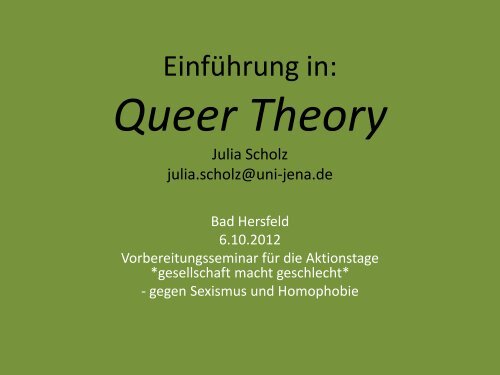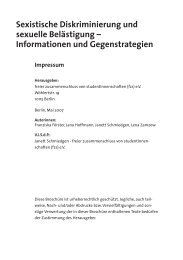Download Einführung in die Queer Theory.pdf ca
Download Einführung in die Queer Theory.pdf ca
Download Einführung in die Queer Theory.pdf ca
You also want an ePaper? Increase the reach of your titles
YUMPU automatically turns print PDFs into web optimized ePapers that Google loves.
<strong>E<strong>in</strong>führung</strong> <strong>in</strong>:<br />
<strong>Queer</strong> <strong>Theory</strong><br />
Julia Scholz<br />
julia.scholz@uni-jena.de<br />
Bad Hersfeld<br />
6.10.2012<br />
Vorbereitungssem<strong>in</strong>ar für <strong>die</strong> Aktionstage<br />
*gesellschaft macht geschlecht*<br />
- gegen Sexismus und Homophobie
def<strong>in</strong>ieren <strong>Queer</strong> <strong>Theory</strong>:<br />
- …. ……<br />
- ……<br />
- …… . …. …..<br />
- ………
Heteronormativität
Variante A:<br />
Gesellschaft<br />
kennt Frauen<br />
und Männer<br />
Variante B:<br />
Man<br />
unterscheidet<br />
zwischen<br />
biologischem<br />
und sozialem<br />
Geschlecht<br />
biol. Geschlecht<br />
F<br />
F<br />
ist<br />
gender w<br />
m<br />
M<br />
M<br />
ist
Variante A:<br />
Gesellschaft<br />
kennt Frauen<br />
und Männer<br />
Variante B:<br />
Man<br />
unterscheidet<br />
zwischen<br />
biologischem<br />
und sozialem<br />
Geschlecht<br />
Variante C:<br />
Man denkt e<strong>in</strong><br />
Kont<strong>in</strong>uum<br />
dazwischen<br />
biol. Geschlecht<br />
F<br />
F<br />
ist<br />
gender w<br />
m<br />
biol. Geschlecht<br />
gender<br />
F<br />
ist<br />
w<br />
M<br />
M<br />
ist<br />
M<br />
ist<br />
m
iol. Geschlecht<br />
F<br />
ist<br />
gender w<br />
m<br />
biol. Geschlecht<br />
gender<br />
Heteronormativ<br />
M<br />
ist<br />
m<br />
DESIRE<br />
M<br />
ist<br />
F<br />
ist<br />
w<br />
Bilder von „www.gala.de“, abgerufen am 3.11.2011 um 12:41
sex<br />
sex<br />
f<br />
a<br />
m<br />
gender<br />
e<br />
w<br />
l<br />
m<br />
o e<br />
gender<br />
target<br />
of<br />
desire<br />
a<br />
n<br />
m<br />
l<br />
e<br />
m<br />
e<br />
n
sex<br />
sex<br />
f<br />
a<br />
w<br />
m<br />
o e<br />
target<br />
“queerness <strong>ca</strong>n never<br />
of<br />
gender def<strong>in</strong>e an identity;<br />
desire<br />
it <strong>ca</strong>n only ever disturb one.” (Edelman,<br />
e<br />
m<br />
2004, p. 17).<br />
l<br />
gender<br />
a<br />
n<br />
m<br />
l<br />
e<br />
m<br />
e<br />
n
Konstruktion
“The concept of difference [between women<br />
and men] has noth<strong>in</strong>g ontologi<strong>ca</strong>l about it. It is<br />
only the way that the masters <strong>in</strong>terpret a<br />
histori<strong>ca</strong>l situation of dom<strong>in</strong>ation.”<br />
Wittig (1992, p. 29)
iol. Geschlecht<br />
Heteronormativ<br />
F<br />
ist<br />
gender w<br />
m<br />
Generative politische Strukturen produzieren biologische<br />
Geschlechtskategorien! Es s<strong>in</strong>d ke<strong>in</strong>e sogenannten "biologischen<br />
Grundlagen".<br />
„The tacit constra<strong>in</strong>ts that produce culturally <strong>in</strong>telligible "sex" ought to<br />
be understood as generative politi<strong>ca</strong>l structures rather that<br />
naturalized foundations.” (Butler, 1990/2006, p. 201)<br />
M<br />
ist
Was<br />
schreiben<br />
wir an <strong>die</strong><br />
Achsen?<br />
biol. Geschlecht<br />
gender<br />
F<br />
ist<br />
w<br />
Geschlechtsidentität<br />
Geschlechtsrolle<br />
Spielzeugpräf.<br />
phys. Aggression<br />
weiblich männlich<br />
weiblich männlich<br />
M<br />
ist<br />
m<br />
Puppen Autos<br />
ke<strong>in</strong>e viel<br />
“gender identity” refers to a person’s self-representation as male or female (with the <strong>ca</strong>veat that some<br />
<strong>in</strong>dividuals may not identify exclusively with either);<br />
(Lee, Houk, Ahmed & Hughes, 2006, p. 489)<br />
….. …… …….<br />
“gender role” (sex-typi<strong>ca</strong>l behaviors) describes the psychologi<strong>ca</strong>l characteristics that are sexually<br />
dimorphic with<strong>in</strong> the general population, such as toy preferences and physi<strong>ca</strong>l aggression;
Was<br />
schreiben<br />
wir an <strong>die</strong><br />
Achsen?<br />
biol. Geschlecht<br />
gender<br />
Genotyp<br />
Phänotyp<br />
F<br />
ist<br />
w<br />
Gonaden<br />
äußere Genitalien<br />
Hormonlevel<br />
Ei-/Samenleiter<br />
…….<br />
M<br />
ist<br />
xx x0 xxy xxxy xyy<br />
xy<br />
m<br />
weiblich männlich<br />
Eierstock Hoden<br />
Vag<strong>in</strong>a Penis<br />
Östro > Testo Östro < Testo<br />
Eileiter Samenleiter<br />
typ. Weiblich typ. männlich
w<br />
? ?<br />
m<br />
Quelle Bild: Huart, Corneille, & Becquardt, 2005, JESP
Fou<strong>ca</strong>ult‘sches Machtverständnis
"Vielfältigkeit von Kraftverhältnissen" (Fou<strong>ca</strong>ult, 1976/1977, S. 93).<br />
"Die Macht ist der Name, den man e<strong>in</strong>er komplexen strategischen Situation <strong>in</strong><br />
e<strong>in</strong>er Gesellschaft gibt." (ebd., S. 94)<br />
"Die Machtbeziehungen verhalten sich zu anderen Typen von Verhältnissen<br />
(ökonomischen Prozessen, Erkenntnisrelationen, sexuellen Beziehungen)<br />
nicht als etwas Äußeres, sondern s<strong>in</strong>d ihnen immanent. (ebd., S. 94)<br />
"Die Machtbeziehungen bilden nicht den Überbau, der nur e<strong>in</strong>e hemmende<br />
oder aufrechterhaltende Rolle spielt - wo sie e<strong>in</strong>e Rolle spielen wirken sie<br />
unmittelbar hervorbr<strong>in</strong>gend." (ebd., S. 94)
Sprache, Diskurs
Butler, KvG, 1995(1993), S. 309: „Wichtig ist<br />
jedoch, daß ke<strong>in</strong>e Macht daran beteiligt ist,<br />
<strong>die</strong> als e<strong>in</strong> Subjekt konstruiert ist, das handelt,<br />
sondern, um e<strong>in</strong>en früheren Ausdruck zu<br />
wiederholen, bloß e<strong>in</strong> ständig wiederholtes<br />
Handeln, das Macht <strong>in</strong> ihrer Beharrung und<br />
ihrer Instabilität ist.“<br />
(….)
Identitätskategorien
Butler, GT, 1990/2006, p.23: „To what extent is<br />
‚identity‘ a normative ideal rather than a<br />
descriptive feature of experience? And how do<br />
the regulatory practices that govern gender also<br />
govern culturally <strong>in</strong>telligible notions of identity?<br />
In other words, the ‚coherence‘ and ‚cont<strong>in</strong>uity‘<br />
of ‚the person‘ are not logi<strong>ca</strong>l or analytic features<br />
of personhood, but, rather, socially <strong>in</strong>stituted and<br />
ma<strong>in</strong>ta<strong>in</strong>ed norms of <strong>in</strong>telligibility.“
“If we, as lesbians and gay men, cont<strong>in</strong>ue to speak<br />
of ourselves and to conceive of ourselves as<br />
women and men, we are <strong>in</strong>strumental <strong>in</strong><br />
ma<strong>in</strong>ta<strong>in</strong><strong>in</strong>g heterosexuality.”<br />
Wittig (1992, p.30)<br />
“From a politi<strong>ca</strong>l analysis of compulsory<br />
heterosexuality it has been necessary to question<br />
the construction of sex as b<strong>in</strong>ary as a hierarchi<strong>ca</strong>l<br />
b<strong>in</strong>ary.” (Butler, GT, 1990/2006, p. 202)
Butler, KvG, 1995(1993), S. 312: „So sehr<br />
Identitätsbegriffe verwendet werden müssen<br />
(…) müssen <strong>die</strong>selben Vorstellungen doch<br />
Gegenstand e<strong>in</strong>er Kritik an den<br />
ausschließenden Operationen zu ihrer eigenen<br />
Herstellung werden“
Bilder von „ http://www.columbia.edu/cu/lweb/eresources/exhibitions/sw25/<strong>ca</strong>se1.html“, „ http://neverbeenlivedbefore.blogspot.com/2010/08/big-law-why-i-am-bad-for-women.html“,<br />
„http://floridaisbetterthantexas.blogspot.com/„. abgerufen am 3.11.2011 um 12:41
Dekonstruktion
Butler, GT, 1990/2006, p.201: „..the<br />
reconceptualization of identity as an effect,<br />
that is, as produced or generated, opens up<br />
possibilities of ‚agency‘ that are <strong>in</strong>sidiously<br />
foreclosed by positions that take identity<br />
<strong>ca</strong>tegories as foundational and fixed.“
Butler, GT, 1990/2006, Chapter 1 VI: „..<br />
Strategies of Displacement“ (…) „What k<strong>in</strong>d of<br />
subversive repetition might <strong>ca</strong>ll <strong>in</strong>to question<br />
the regulatory practice of identity itself?“
Performativität
Butler, GT, 1990/2006, p. 185: „In other words, acts,<br />
gestures, and desire produce the effect of an <strong>in</strong>ternal<br />
core or substance, but produce this on the surface of<br />
the body, through the play of signify<strong>in</strong>g absences<br />
that suggest, but never reveal, the organiz<strong>in</strong>g<br />
pr<strong>in</strong>ciple of identity as a <strong>ca</strong>use. Such acts, gestures,<br />
enactments, genrally construed, are performative <strong>in</strong><br />
the sense that the essence or identity that they<br />
otherwise purport to express are fabri<strong>ca</strong>tions<br />
manufactured and susta<strong>in</strong>ed through corporeal signs<br />
and other discursive means.“ (….)
Identitätskategorien<br />
Heteronormativität<br />
Fou<strong>ca</strong>ult‘sches Machtverständnis<br />
Konstruktion<br />
<strong>Queer</strong> <strong>Theory</strong><br />
Dekonstruktion<br />
Sprache, Diskurs<br />
Performativität
Danke für Eure Aufmerksamkeit!<br />
julia.scholz@uni-jena.de
Literatur<br />
Butler, J. (1990/2006). Gender Trouble : Fem<strong>in</strong>ism and the Subversion of Identity. New York (u.a.): Routledge.<br />
[Orig<strong>in</strong>alausgabe 1990; Seitenzahlen beziehen sich auf Nachdruck von 2006.]<br />
Butler, J. (1995, orig. 1993). Körper von Gewicht. Frankfurt/Ma<strong>in</strong>: Suhrkamp.<br />
Edelman, L.. (2004). No Future: <strong>Queer</strong> <strong>Theory</strong> and the Death Drive. Durham: Duke University Press.<br />
Fou<strong>ca</strong>ult, M. (1987). Sexualität und Wahrheit I: Der Wille zum Wissen. Berl<strong>in</strong>: Suhrkamp.<br />
Lee, P.A, Houk, C.P., Ahmed, S.F. & Hughes, I.A. (2006). Consensus statement on management of <strong>in</strong>tersex disorders.<br />
Pediatrics, 118, 488-500.<br />
Wittig, M. (1992). The straight m<strong>in</strong>d: And other essays. New York: Beacon Press.<br />
Bildquellen:<br />
Huart, J., Corneille, O. & Becquardt, E. (2005). Face-based <strong>ca</strong>tegorization, context-based <strong>ca</strong>tegorization, and distortions<br />
<strong>in</strong> the recollection of gender ambiguous faces. Journal of Experimental Social Psychology, 41, 598-608.<br />
Bilder von WWW-Seiten (abgerufen am 3.11.2011 um 12:41):<br />
http://floridaisbetterthantexas.blogspot.com/<br />
http://neverbeenlivedbefore.blogspot.com/2010/08/big-law-why-i-am-bad-for-women.html<br />
www.gala.de<br />
www.columbia.edu/cu/lweb/eresources/exhibitions/sw25/<strong>ca</strong>se1.html<br />
www.k<strong>in</strong>derladen-engelbostel.de/pages/wir-ueber-uns/paedagogischer-schwerpunkt.php





